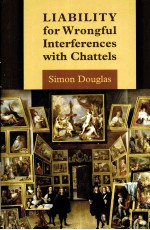
- 作 者:SIMON DOUGLAS
- 出 版 社:OREGON
- 出版年份:2011
- ISBN:1849461511
- 标注页数:222 页
- PDF页数:240 页
请阅读订购服务说明与试读!
订购服务说明
1、本站所有的书默认都是PDF格式,该格式图书只能阅读和打印,不能再次编辑。
2、除分上下册或者多册的情况下,一般PDF页数一定要大于标注页数才建议下单购买。【本资源240 ≥222页】
图书下载及付费说明
1、所有的电子图书为PDF格式,支持电脑、手机、平板等各类电子设备阅读;可以任意拷贝文件到不同的阅读设备里进行阅读。
2、电子图书在提交订单后一般半小时内处理完成,最晚48小时内处理完成。(非工作日购买会延迟)
3、所有的电子图书都是原书直接扫描方式制作而成。
1: INTRODUCTION 1
Ⅰ. The Focus on the Law of Torts 1
Ⅱ. The Proposed Structure 3
PART Ⅰ: THE RIGHTS PROTECTED BY THE CHATTEL TORTS 7
2: PROPERTY RIGHTS RELATING TO CHATTELS 9
Ⅰ. Property Rights 9
A. Rights in Rem and Rights in Personam 9
B. Personal Rights and the Chattel Torts 12
Ⅱ. Chattels 14
Ⅲ. Intangibles 16
3: TYPES OF PROPERTY RIGHTS 19
Ⅰ. Ownership 20
A. Content of Ownership 21
B. Relativity of Ownership 24
C. Acquisition 27
Ⅱ. Possessory Rights 30
Ⅲ. Chattel Leases 33
Ⅳ. Security Interests 36
A. Possessory Security 37
B. Non-possessory Security 39
Ⅴ. Equitable Title 39
A. The Position of Beneficiaries Suing in the Chattel Torts 40
B. Proprietary Status of an Equitable Interest 44
Ⅵ. Conclusion 48
PART Ⅱ: LIABILITY FOR INTENTIONAL INTERFERENCES WITH CHATTELS 49
INTRODUCTION TO PART II 49
4: CONVERSION 51
Ⅰ. Historical Development of Conversion 51
A. Origin of Conversion 52
B. Expansion 55
Ⅱ. Features of the Modern Action 61
A. Conversion's Status as a Tort 62
B. The Basis of Liability in Conversion 64
Ⅲ. Conclusion 77
5: DETINUE 78
Ⅰ. The Basis of Liability 78
A. Orthodox View: A Detention 79
B. Alternative Approach: Careless Loss 84
C. Tort or Vindicatio? 89
Ⅱ. The Abolition of Detinue 90
Ⅲ. Conclusion 94
6: TRESPASS 96
Ⅰ. Historical Development of Trespass 97
A. Origins of the 'Directness' Requirement 97
B. The Meaning of 'Directness' 99
C. The Relevance of the Defendant's Mental State 101
Ⅱ. The Emergence of the Modern Tort of Trespass 104
A. From 'Direct' to 'Intentional' Interference 105
B. The Meaning of 'Intentional Interference' in Trespass 111
Ⅲ. Conclusion 114
7: A SINGLE TORT 115
Ⅰ. Common Features of the Three Torts 116
A. The Basis of Liability 116
B. The Standard of Liability 120
Ⅱ. Calls for the Formal Recognition of the Single Tort 123
A. The 18th Report: Calls for a Single Tort 123
B. The Torts (Interference with Goods) Act 1977 125
Ⅲ. Justifying the Structure of the Chattel Torts 126
A. Historical Explanations for Strict Liability 127
B. Modern Theories of Strict Liability 129
Ⅳ. Conclusion 137
PART Ⅲ: LIABILITY FOR UNINTENTIONAL INTERFERENCES WITH CHATTELS 139
INTRODUCTION TO PART III 139
8: INTRODUCTION TO THE TORT OF NEGLIGENCE 141
Ⅰ. Historical Development of Negligence 141
A. Early History 142
B. Re-orientation of Case from 'Indirect' to 'Negligent' 143
Ⅱ. The Basis of Liability: 'Interference' or 'Damage'? 145
A. The Meaning of 'Damage' 146
B. 'Interference' as the Basis of Liability 150
Ⅲ. Conclusion 158
9: ESTABLISHING 'DUTY' AND 'FAULT' IN NEGLIGENCE 159
Ⅰ. An Additional Requirement of Proving Duty? 160
A. The Three-Stage Test 161
B. The Role of Policy in Chattel Cases: The Nicholas H 163
Ⅱ. The Need for Fault 168
A. The Meaning of 'Fault' 169
B. Justifying the Need for Fault 171
C. Establishing Fault in Chattel Cases 176
Ⅲ. Conclusion 182
PART Ⅳ: APPLYING THE STRUCTURE TO REMEDIES 185
10: COMPENSATION 187
Ⅰ. Establishing a Loss 188
A. Assessment of Damages in the Intentional Chattel Torts 189
B. Assessment of Damages in the Tort of Negligence 195
Ⅱ. Causation of Loss 198
A. Causation of Loss in the Intentional Chattel Torts 199
B. Causation of Loss in the Tort of Negligence 201
C. Justifying the Different Approaches to Causation of Loss 203
Ⅲ. Conclusion 204
11: CONCLUSION 206
BIBLIOGRAPHY 209
INDEX 217
